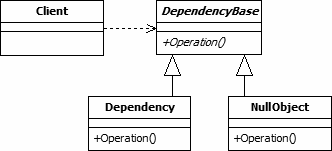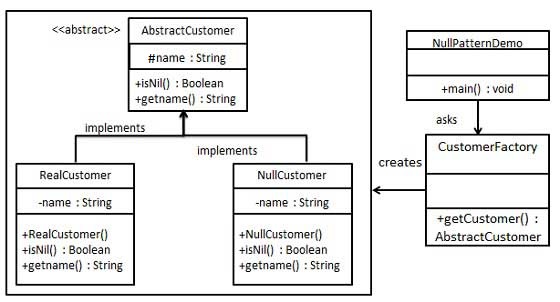Null Object Pattern
A null object is an object with a defined neutral behavior, which allows us to write a cleaner and faster code. It can be said that a null object “reflects a do nothing relationship”.
Null Object Design
When working with references, one is usually forced to check if that reference exists (i.e. is null) before invoking any method. Instead of putting a lot of if-null checks which reduce readability, one can use a null node design pattern to provide a polymorphic object with a “default behavior” when no data is present.
Following image (taken from GeeksForGeeks) shows a simple null object design.

In the previous image the DependencyBase represents an abstract base class that describes the interface that some Clinet may use. Dependency implements all abstract methods as expected, while the NullObject implements a default (do nothing/return 0/return empty collection) behavior of all methods listed by the DependencyBase, and as such can also be used by the Client.
The following image shows a simple example of a null object design pattern combined with a factory (factory design pattern) which decides whether to create a real object or a null object.

Advantages and disadvantages
Advantages:
- There is a class hierarchy, so a null objects can be used instead of real objects.
- Makes the Client code a lot cleaner and simpler, the client no longer has to worry about getting a null reference. It will always get a reference to a valid object, even if that object does nothing.
- It can also speed up the code, by eliminating unnecessary if checks.
Disadvantages:
- Can waste memory if there are a lot of null objects. To solve this, one usually implements the null object as a singleton.
- The “do-nothing” behavior may not be well defined. If there are multiple clients, they must all “agree” on what a default behavior is, or we may need to implement different null objects.
- Sometimes a null object must be replaced by a real object. This can be implemented by using the state design pattern - which will be described in more detail in a future blog post.
Conclusion
As we have seen, the null objects may have some disadvantages which can be avoided by making a smarter design. Null node can reduce the complexity of the Client code which make this extra time to make a better design worth it. We are using the Null Object design pattern (combined with a state pattern) for implementing the tree data structure.
Image references
All images are taken from Geeks-For-Geeks and the TutorialsPoint websites. All references are provided in-text.